To be considered an expert in contemporary combative firearms training all that’s required is a computer and a habit of persistent self-promotion. In the cyber world, street-cred is largely acquired by sarcasm and volume; those with actual hands-on experience need not apply. The true charlatans of the art tend to a self-assured dogmatism; tactics for armed self-defense are generally black and white propositions in their imaginations. They tend to speak ex cathedra and phrases such as “let me explain why I say that…” and “my experience leads me to believe that…” don’t appear in their lexicon.
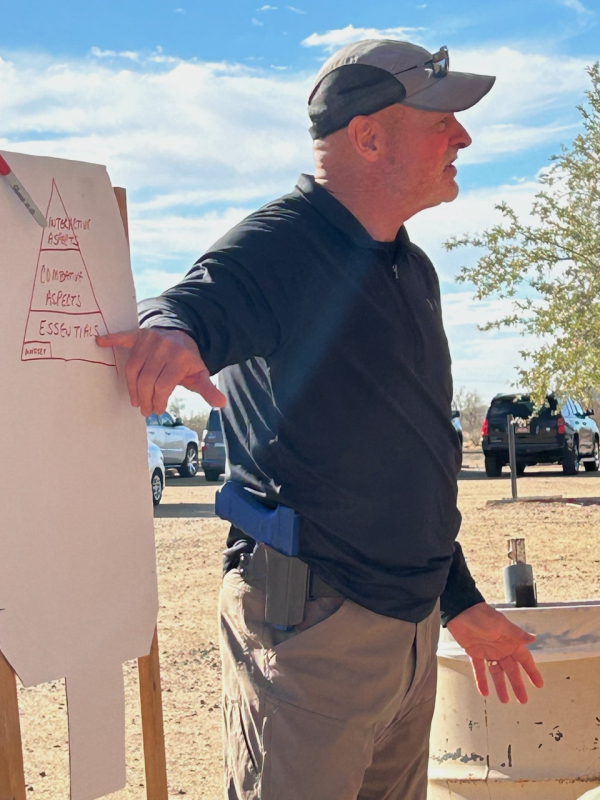
Two bona fide experts with flawless credentials in combative firearms training are Dave Spaulding and Richard Nance. Since “retiring” from Handgun Combatives, Dave has become a frequent contributor to Shooting Wire and The Tactical Wire while Richard is one of the most prolific trainers in the industry with ongoing outlets in print media, television shows and podcasts. Being close friends, they get together for a yearly pilgrimage to Tombstone, Arizona where Dave has become an expert on the more esoteric aspects of the Shootout at the OK Corral. This year, Gunsite Instructor Freddie Blish persuaded them to augment their trip with a collaborated class on “Pistolcraft Essentials.” As testament to their popularity, the class sold out in 17 hours, months prior to the event.
One measure of superb instruction is the stature of the students it attracts. This Pistolcraft Essentials class drew five Gunsite Instructors including CEO Ken Campbell, retired GLOCK National Sales Manager Bob Radecki, USCCA executive Julie Faris and was photographed by the guru of firearms photography, Yamil Sued.
In preparing the curriculum, Dave said that he and Rich asked themselves what they considered to be the most important elements of combative pistol craft. This developed into “The Best of Dave and Rich class” with Dave as the lovable curmudgeon while Rich was the poster boy for “How to Win Friends and Influence People.”
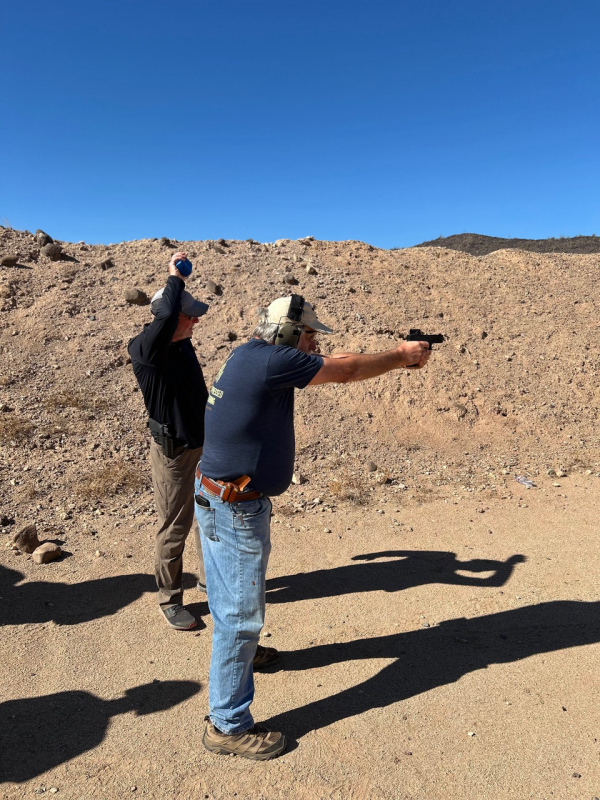
Dave took the helm on day one and set the scene with, “there’s no such thing as an ‘average gunfight’……if you’re in a gunfight, it won’t be like you just finished your 5th day at Gunsite - it will be more like you just woke up and haven’t had a cup of coffee yet….the single biggest reason people lose a gunfight is fear and the best way to overcome fear is to have confidence that your skills will work……realize that you can do everything right and still lose; Murphy has a vote in what happens.”
With the scene fittingly set, Dave led a discussion on the difference between “mindset” and “state of mind.” Dave feels that mindset involves a previous decision, much like Cooper’s color code of awareness with a pre-determined “trigger” that will dictate action on your part. By comparison, state of mind is transitory and can be dictated by fatigue, sickness or distraction which weakens your awareness.
Any Spaulding class will incorporate the use of numerous, varied shooting drills designed to test various essential skills. If you check YouTube, Dave explains and demonstrates most of them. A unique feature that he brings to the class is summarizing the specific skill needed to successfully accomplish the drill and how to grade your own performance by asking yourself 4 questions after every time you draw and shoot:
1. When drawing and presenting my gun, did the sights/dot arrive on the target where I wanted? Why or why not?
2. Did my shot go where my sights/dot were? Why or why not?
3. Did the sights/dot return to where it started after I shot? Why or why not?
4. Was my trigger reset and ready to fire the next round when the sights/dot returned to the target?
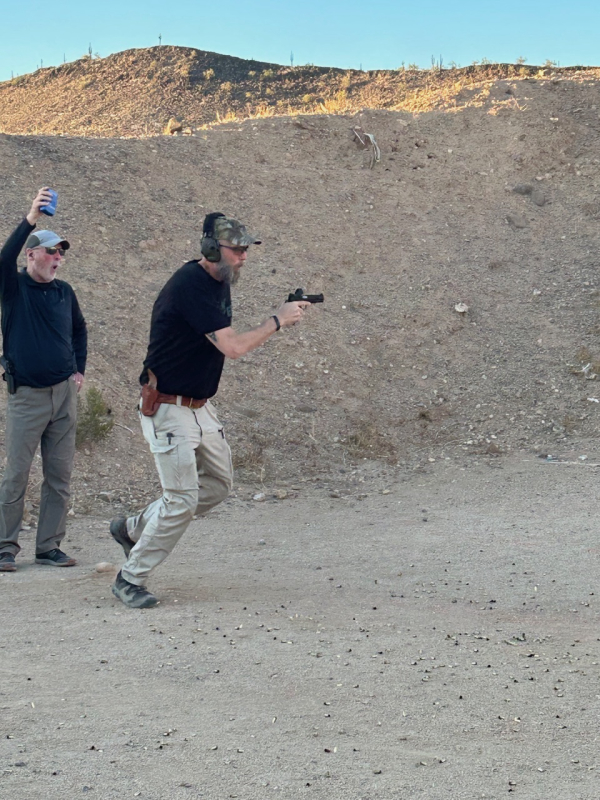
Without this kind of analysis, time and ammunition is often wasted by copious amounts of mindless shooting. Repetition only has value if you practice the right thing; analysis helps avoid entrenched training scars.
Rich Nance took the lead on the second day and began the class by referencing the adage that there’s no virtue in reholstering your handgun quickly. He said that that’s not necessarily true and then explained why. When he was a rookie police officer, he responded to a domestic disturbance. A young man had gone berserk, taken a baseball bat and smashed the interior of his mother’s house…. she called the cops. As he responded to the call, the mother and son were on the front lawn. When Rich got out of the squad car, the perp started to advance toward him with the baseball bat taunting Rich to shoot him. Rich had drawn his sidearm, was pointing at the advancing young man and had taken the slack out of the trigger. The perp then dropped the bat and started to charge at Rich. Shooting him now was no longer an option as Rich wasn’t being assaulted with a lethal weapon, so Rich had to quickly reholster his side arm and find other options to deal with the perp. Had he fumbled the reholstering, the assailant would have closed the distance before Rich could secure his handgun and used his martial arts training to retain his pistol, block the perp’s punches and ultimately subdue him. Rich summarized the story by saying that managing and controlling the distance to the threat is critical and you may not be able to use your gun to accomplish that.

Rich’s long and extensive history in various forms of martial arts combined with the nature of extreme close quarter combative skills made Rich’s presentation tactile, aerobic and strenuous. The morning was spent working on three basic techniques to manage/control the space between you and your attacker.
The first method Rich calls “the Heisman Technique”- it’s a basic straight arm to the perp’s chin. Striking the assailant in the chin with the palm of your hand shifts the attacker’s thoughts from what he’s about to do to you to what you’re currently doing to him. However, a straight arm to the chin alone is inadequate. It must be combined with lateral movement. As the palm of your hand makes contact with the chin of the perp, you move in the direction of your weapon, which you draw while moving.
The second method is the “elbow strike.” It’s accomplished by moving your non-dominant hand toward the top of your head while stepping into the attacker striking them in the chest with your elbow. Then, as with the chin strike, you move laterally in the direction of your gun while you draw.
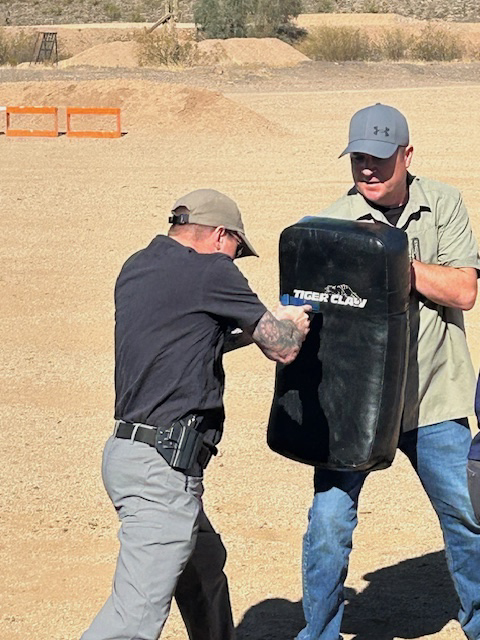
The third technique is the "muzzle strike.” This method differs from the first two in that the gun is already in hand, gripped with either one or two hands. It is performed by stepping forward with the off-side foot. As the foot hits the ground, the gun muzzle is thrust sharply into the torso of the perp and retracted as quickly as the initial thrust. There are potential risks with this technique. If the distance to the attacker’s torso is too close, the thrust won’t develop enough momentum to be effective. Conversely, if the distance is too far you can’t develop enough force to be effective. Also, when the muzzle strikes the attacker’s torso, the gun may come out of battery. This results in the need to tap the magazine and rack the slide. Rich gave the caveat that a muzzle strike constitutes the use of deadly force. Therefore, if you’re not legally justified in shooting the perp, you’re probably not justified in using a muzzle strike.
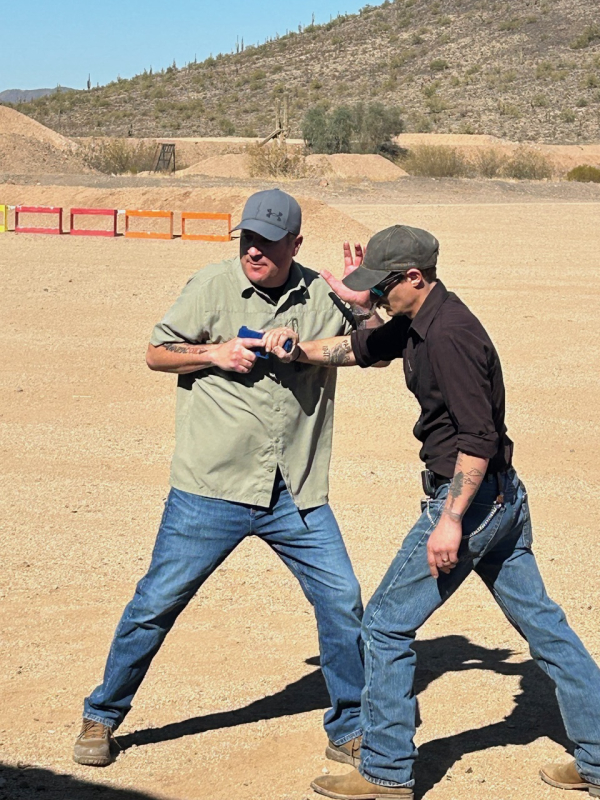
In-hand weapon retention techniques were next on Rich’s agenda. His manner of instruction, as it was with the strike techniques, is to explain potential scenarios where immediate action is required. Next, he explains the steps of the maneuver, demonstrates the steps and then has the students pair off and practice the technique with a blue gun. By the end of the morning session, the class had performed enough reps of all of the above procedures to ensure that they could exchange the blue guns for real guns. The afternoon session was spent safely replicating the morning’s drills with live ammo.
The symbiotic relationship between Dave and Rich works well because they’re having fun. The resultant experience is as thought provoking as it is physically demanding. Will they collaborate and present this class again? Perhaps. In closing out the class Dave stated, “Retiring is doing what you want to do and I love working with people like you.” That could be a harbinger of more classes to come. My recommendation is to keep a frequent eye on Nance’s website: www.wartac.com as their classes fill quickly.
— Greg Moats